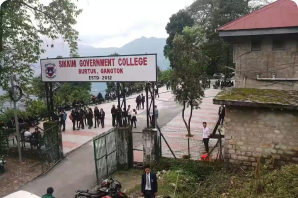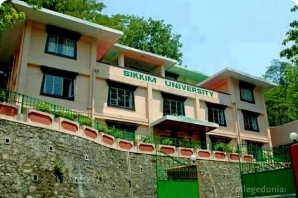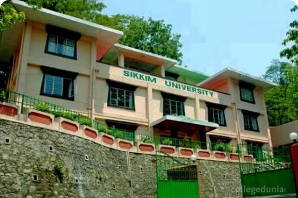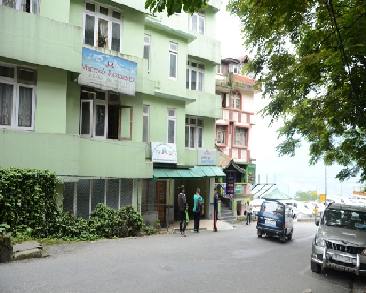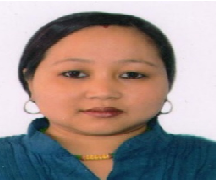Anthropology Department
- Maiti, S. (2014). A tough road ahead - intimate partner violence (IPV) during pregnancy: a study of rural Uttar Pradesh (India). Sociological Bulletin 63(3): 386-406.
- Wouters, J.J.P. (2014). Performing democracy in Nagaland: past polities and present politics. Economic and Political Weekly XLIX (16): 59-66.
- Wouters, J.J.P. (2014). Book Review: Gellner, D.N. (ed.) Borderland Lives in Northern South Asia. Journal of the Anthropological Society of Oxford, New Series, VII (1): 223-226.
- Wouters, J.J.P. (2015). Land and Tribal Ambivalences. In: Challenges of Land Development. Kohima (Ed. Takatemjen), pp. 72-85. Clark Centre of Peace Research and Action, Kohima.
Botany Department
- Chhetri, D.R. (2014). Metabolic changes in Rhododendron arboreum Smith in response to abiotic stress induced by salinity and abscisic acid. International Journal of Research in Applied, Natural and Social Sciences 2(6): 91-102.
- Chhetri, D.R. (2014). Medicinal Plants of the Himalaya: Production Technology and Utilization. Agrobios, Jodhpur, ISBN: 978-81-7754-558-6.
- Chhetri, D.R. (2014). L-myo-Inositol -1-phosphate synthase from Diplopterygium glaucum. Scholars Press, Saarbrucken, pages172. ISBN: 978-3639711462.
- Barik, S.K., Adhikari, D., Chettri, A. and Singh, P.P. (2015). Diversity of Lianas in Eastern Himalayas and Northeastern India.In: Biodiversity of Lianas, Sustainable Development and Biodiversity (Ed. N. Parthasarathy), 99-121. Springer International Publishing, Cham (ZG), Switzerland. ISBN 978-3-319-14592-1.
Chemistry Department
- Ghosh, P., Roy B. G
., Mukhopadhyay S. K., and Banerjee, P. (2015). Recognition of fluoride anion at low ppm level inside living cell and from fluorosis affected tooth and saliva samples. RSC Adv. 5: 27387-27392. - Banerjee, M., Chatterjee, A. Kumar, V., Bhutia, Z. T., Khandare, D. G., Majik M. S., and Roy, B.G. (2014). A simple and efficient mechanochemical route for the synthesis of 2-arylbenzothiazoles and substituted benzimidazoles. RSC Adv. 4: 39606- 39611.
- Bazracharza, A., Rana, M., Roy B. G., Tiwari, A
., and Tripathi, A. (2014). Optical characterization of medicinal plant’s extracts used for the treatment of diabetes. Journal of Herb. Spic. Med. Plant. 21: 86-101.
Chinese Department
- Roy, D. (2014). Chinese humanist thought on state and society-is there something to learn from ancient Chinese philosophical writings for modern Governments. International Journal of Language and Linguistics 1(1):15-29.ISSN: 2374-8850.
- Roy, D. (2014). Fifth century common era- reorienting Chinese Buddhist monastic tradition, redefining India-China buddhist monastic relations: a critical study.Working Paper Series, Emerging Scholar Papers http://indiachinainstitute.org/wp-content/uploads/2014/04/New-York-Edited-Paper-Dhriti-Roy.pdf), India China Institute, The New School, New York, pp. 1-16.
Commerce Department
- Shankar, A.N. (2015). Longitudinal appraisal of financial inclusion parameters for North-East India. In: Development of North-East India Multidimensional Perspective Volume 1 (Ed. R.P. Vadhera), pp. 1-16. Manglam Publishers and Distributors India, Delhi. ISBN 978-93-82816-20-1.
Computer Applications Department
- Rai, R. (2014). IASC-CI: Improved Ant based Swarm Computing for Classifying Imagery. International Journal of Computer Science and Information Technologies 5 (3): 4181-4189. ISSN: 0975-9646.
- Rai, R. (2014). Validation of range of resistance of sensor through sensor data acquisition using simplot: acase study. International Journal of Advanced Research in Computer Science and Software Engineering 4 (3): 1251-1255. ISSN: 2277 128X.
- Rai, R. (2014). IAPSO-TCI: Improved ant and particle swarm based optimization techniques for classifying imagery. International Journal of Computer Science And Information Technologies 5(4): 5963-5969. ISSN: 0975-9646.
- Chettri, L. (2014). Visual cryptography scheme based on pixel expansion for black & white image. International Journal of Computer Science and Information Technologies 5 (3): 4190-4193.
- Sebastian S. and Ray, P. P. (2015). Development of IoT invasive architecture for complying with health of home. In: Proceedings of I3CS, Shillong, pp.79-83. IGI Global, Shillong.
- Sebastian S. and Ray, P. P. (2015). When soccer gets connected to internet. In: Proceedings of I3CS, Shillong, pp.84-88. IGI Global, Shillong.
- Ray, P. P. and Rai, R. (2014). Validation of range of resistance of sensor through sensor data acquisition using simplot: a case study. International Journal of Advanced Research in Computer Science and Software Engineering 3(4): 1251-1255. ISSN: 2277-128X.
- Ray, P. P. (2014). Home health hub internet of things (h3iot): an architectural framework for monitoring health of elderly people. In: Proceedings of IEEE ICSEMR, Chennai, (Indexed in IEEE Explore).
- Ray, P. P. (2014). Internet of things based physical activity monitoring (pamiot): an architectural framework to monitor human physical activity. In: Proceedings of CALCON (National Conference on Electrical, Electronics, and Computer Engineering, pp.32-34, Kolkata.
Economics Department
- Choubey, M. (2015). Financial Inclusion in Bihar: Role of Business Correspondence. International Journal of Research in Commerce, Economics and Management 3 (69): 93-96.
- Choubey, M. (2015). Managing human resource in microfinance institutions - A case study of Bihar. Asia Pacific Journal of Marketing & Management Review 4 (3): 39-51. ISSN 2319-2836.
- Pandey, P. and Choubey, M. (2015). Production of milk and livelihood status of dairy co-operative member and non-member household in East Sikkim, India. International Journal of Agricultural Economics and Management 4 (1): 29-37.
- Choubey, M. (2015). Area and production of tea in India: an analysis. International Journal of Social Science & Interdisciplinary Research 4 (4): 57-62.
- Choubey, M. (2014). Production of pulses in India: an econometric analysis. International Journal of Current Research, International Journal of Current Research 6 (9): 8893-8896.
- Choubey, M. (2014). Economic analysis of production and export of garlic. International Journal of Current Research 6 (7): 7698-7702.
- Singh, M. Amarjeet and Singha, K. (2015). Ethnicity and Sikkimese identity in Sikkim. Eastern Quarterly 8(3 & 4): 131–41.
- Singha, K., Choudhary, R. and Vishnu, K. (2014). Growth and diversification of horticulture crops in Karnataka: an inter-district analysis. Sage Open 1-7: DOI: 10.1177/2158244014548018.
- Singha, K. (2014). Development of horticultural sector in India– an Assessment. Journal of Economic Philosophy 2(1): 1-8. ISSN: 2329-941X.
- Kundu, R. (2014). Potential of Organic Farming for Providing Sustainable Livelihood: A Study in East Sikkim. In: Development, Environment and Sustainable Livelihood (Eds. S.K. Datta and A. Sengupta), pp 254-271. Cambridge Scholars Publishing, MIL. ISBN: 9781322216003.
- Kundu, R. (2014). Climate Change in the Eastern Himalaya: Impact on Livelihoods, Growth and Poverty. In: North East Studies and Policy Research (Eds. S. Hazarika and R. Banerjee), pp. 3-32.Jamia Millia Islamia, Academic Publication, New Delhi. ISBN: 978-93-83931-29-3.
- Guha, P. (2015). Economics of Tourism in Mizoram: A SWOT Analysis. International Journal of Current Research 6(7): 7557-7562.
- Guha, P. (2015). A Study on the Differences in the Banking Parameters between Pre- and Post-Financial Inclusion Periods: Some Evidence for India. The IUP Journal of Bank Management 14(1): 39-56.
- Guha, P. (2014). Small Scale Tea Cultivation in Assam. In: Identity, Politics and Economic Development in North East India, (Eds. K.Singha and M.A.Singh), pp. 353-362. Concept Publishing Company Pvt. Ltd., New Delhi. ISBN-13:978-93-5125-040-1.
- Guha, P. (2015). Trans-border Trade Intensity: A Case for India's North East. In: Development Perspectives in North East India: Micro and Macro Studies (Ed. R.K.P.G. Singha), pp. 9-25. Lakshi Publishers & Distributors, New Delhi. ISBN: 978-93-82120-58.
- Singha, K. and Singh M. Amarjeet (2014). Identity, Politics and Economic Development of North-East India. Concept Publishing Company, New Delhi, 372 pages. ISBN 978-93-5125-040.
- Mohapatra, R. (2015). Decomposition of SBM Technical Efficiency of the Secondary Education System into Radial Efficiency and Mix Efficiency: A State-wise Analysis in India. Journal of Social Sciences Research 7(2): 1304-1315
Education Department
- Misra, S. and Kapoor, P. (2014). Professional orientation for creating human resources excellence in teacher education. In: Prospects and Issues Concerning Education at Secondary Level (Ed. N.S.C.Momin and J.V. Madhusudan), pp. 378-398. Manas Publishers and Distributors, Jaipur. ISBN 978-81-921743-8-9.
- Kishor, V. and Bhadwal, S. P. (2014). Innovating education: promoting edutainment through films as teaching aid. Contemporary Research in India 4 (2): 16-19.ISSN: 2231-2137.
- Kishor, V. (2014). Parental encouragement. Research Journal of Humanities and Social Sciences 5 (2): 176-179. ISSN: 0975-6795.
- Kishor, V. and Walia, J. (2014).Role of guidance and counselling services in schools for universalisation of elementary education. Indian Journal of Humanities 4 (3): 82-85. ISSN: 2248-9541
- Kishor, V. (2014). Academic achievement of high school students having differential levels of reasoning ability. Shaikshiki-An International Journal of Educational Research 1(1): 20-27.ISSN: 2394-191X.
- Kishor, V. (2015).Youth and politics. In: Youth Development in India-Voice for the Youth, Voice of the Youth (Ed. D. Sarmah), pp. 19-25. Shanti Educational Foundation, Guwahati. ISBN: 978-93-83580-42-2.
English Department
- Sengupta, J. (2015). The Baul sursadhak: the tradition and individual Talent. Journal of Literature and Art Studies 5 (2): 151-157. David Publishing, USA. ISSN 2159-5836.
- Yadav, R.B. (2014). Colonial historiography vs postcolonial historiography: history, myth and allegory in Shashi Tharoor’s The Great Indian Novel. Lapis Lazuli 8 (2): 7-13. ISSN-2249-4529.
Geography Department
- Firdos, S. (2014).Book Review of Churning the earth: themaking of global India. Millennial Asia 5 (1): 119-121.
- Firdos, S. (2014). Changing Land Ownership Patterns and its Impact on Social Relations in Sikkim. In: Land Records Management in India: A Plea for Reforms (Eds. A.A.A. Faizi and H.C. Behera), pp. 205-213. Concept publishing Company, New Delhi.
- Ahmed, R. (2014). Anxiety, violence and the postcolonial state: understanding the anti-Bangladeshi rage in Assam. Perceptions: Journal of International Affairs 29 (1): 55-70.
- Ahmed, R. (2014).Assam’s D-Voters. Himal, May 26, http://himalmag.com/assams-d-voters/
- Hannan, A. (2014). Public-private partnership in elementary education and the process of social inclusion in Sikkim. In: Right to Education: Challenges and Strategies (Eds. M. Sarumathy and Gyanmudra), pp. 70-77. National Institute of Rural Development and Panchayati Raj, Hyderabad.
- Khawas, V. (2014). Indigenous knowledge in use of disaster risk reduction: a case of Sikkim Himalaya. In: Proceedings of the International Conference on Pathways toclimateresilientlivelihoods in the Himalayan River Basins (Eds. Nair, A. and P. K.Sing et al), pp. 32-33. IRMA, Anand, Gujarat.
Hindi Department
- Singh, A.V. (2014). Darshkon ke Jehan Me Hamesa Moujud Rahega. Samved 73- 75: 207-209.
- Singh, A.V. (2014). Apne Ji Me Hamne Thani Aur Hai. Arya Sandesh 11: 78-80.
- Singh, A.V. (2015). Hey Wardi Hamen Khsama kar Do. Samved 84: 109-111.
- Singh, A.V. (2015). Ek Mukammal Taamir. Shabdarth 10: 122 –123.
- Dviwedi, S.K. (2014). Stree Jivan Aur Divya. Anbhai Sanch 5: 84 -87.
- Prasad, B. (2014). Sahitya Aur Samaj: Analochit Paksh. Pravah 3: 10-11.
History Department
- Krishna Ananth, V. (2014). Where does the Aam Aadmi Party stand? Economic and Political Weekly Vol - XLIX No. 14, April 5, 2014, pp 13-15.
- Krishna Ananth, V. (2014). An analysis of the poll scene in Tamil Nadu. Economic and Political Weekly, Vol - XLIX No. 17, April 26, 2014, pp 14-15.
- Krishna Ananth, V. (2014). Exemplary teacher who left behind a school of thought. Economic and Political Weekly, Vol - XLIX No. 41, October 11, 2014, pp 30-31.
- Krishna Ananth, V. (2014). Politics in the times of churning - a jounalist’s perception. Daya Publications, Madurai. ISBN: 9788192219011.
- Krishna Ananth, V. (2015). Achutanandan’s splendid isolation. Economic and Political Weekly, Vol L- No 13, March, 28, 2015, pp-17-19.
- Krishna Ananth, V. (2015). The Indian Constitution and social revolution: Right to Property since Independence. SAGE Publications India, Private Limited, New Delhi, (Sage Modern Indian History Series) ISBN: 9789351500636.
Horticulture Department
- Subba, P., Mukhopadhyay, M., Mahato, S.K., Bhutia, K.D., Mondal, T.K. and Ghosh, S.K. (2014). Zinc stress induces physiological, ultra structural and biochemical changes in mandarin orange seedling. Physiology and Molecular Biology Pl. 20: 461-473.
- Suresh, C.P. Bhutia, K.D. Shukla, G. Pradhan, K and Chakravarthy, S. (2014). Wild edible fruits of Sikkim Himalayas. Journal of Tree Science 33: 43-48.
- Bazracharza, A., Rana, M., Roy B., Tiwari, A. and Tripathi, A. (2014). Optical characterisation of medicinal plants’ extracts used for the treatment of diabetes. Journal of Herbs, Spices & Medicinal Plants. DOI: 10.1080/10496475.2014.910584.
- Pradhan, S., Manivannan, S. and Tamang, J.P. (2015). Proximate, mineral composition and anti oxidant properties of some wild leafy vegetables. Journal of Scientific and Industrial Research 74: 155-159.
International Relations Department
- Pradhan, Sunil, (2015). Politics in Nepal: monarchy, democracy and governance, RCSS Policy Studies 59, New Delhi: Manohar.
Management Department
- Rama Devi, V. (2015). Service quality gap – a literature review, SS International Journal of Economics and Management. International Journal of Research in Organizational Behavior and Human Resource Management 5(2): 11-18.
- Rama Devi, V. (2014). Human resource development climate in healthcare and banking sector. Middle East Journal of Scientific Research 21(7): 1055-1060.
- Rama Devi, V. (2014). Impact of technology on employee engagement – detrimental or beneficial? Pacific Business Review International 7(4): 10-12.
- Rama Devi, V. (2014). Empirical study on demographic correlates of emotional intelligence of engineering students. Prabandhan: Indian Journal of Management 7(12): 33-44.
- Rama Devi, V. (2014). Impact of knowledge management on organizational performance in higher educational institutions. Scholars Journal of Economics, Business and Management 1(9): 400-403.
- Das, P.K. (2015). Information system in enhancing managerial competencies: an organisational perspective, JCSE International Journal of Computer Sciences and Engineering 3(1): 136-140.
- Das, P.K. (2014). Referencing system in writing: Asia style. Journal of International Academic Research for Multidisciplinary 2(2): 301-304.
- Das, P. K. (2014). Problems and prospects of tourism industry in Sikkim. The Journal of Social Science Researcher 5 (3): 32-43.
- Das, P.K. (2015). Industrial Relations – an Indian Perspective. Kunal Books, New Delhi, ISBN: 978-93-82420-73-6.
- Murari, K. (2015). Exchange rate volatility estimation using GARCH models, with special reference to Indian Rupee against world currencies. IUP Journal of Applied Finance 21(1): 22-37.
- Murari, K. and Kumari, P. (2015). Contract farming in Indian perspective: a necessity for sustainable rural development/sustainable agriculture in 21st century: strategic approaches & practices. In: Sustainable Agriculture in 21st century: Strategic Approaches & Practices. (Eds. N. H. Zaidi and M. M. Khan), pp. 49-59. Regal Publication, New Delhi. ISBN: 978-81-8484-408-5.
Mass Communication Department
- Basnett. P. and Guha. S. (2014). Kanchenjunga and Sikkim Press: How media started its Practice in Sikkim. IOSR Journal of Humanities and Social Science 19 (10): 20-24.
- Buragohain, N. (2014). A Glimpse of media of North East India. In: Journalism and Media Industry of North East India (Ed. Z. U. Alam), pp. 1-19. Eastern Book House, Guwahati. ISBN no: 978-93-83252-31-2.
Microbiology Department
- Chettri, R. and Tamang, J.P. (2014). Functional properties of Tungrymbai and Bkang, naturally fermented soybean foods of India. International Journal of Fermented Foods 3: 87-103.
- Rai, Ranjita, Kharel, N. And Tamang, J.P. (2014). HACCP model of kinema,a fermented soybean food. Journal of Scientific and Industrial Research. 73: 588-592 (Impact factor: 0.505).
- Gajamer V. R. and Tiwari, H.K. (2014). Prevalence of Gastrointestinal Disease and Its Associated Risk Factors in Sikkim and Darjeeling Districts. Journal of Community Health.DOI:10.1007/10900-014-9826-x
- Tamang, J.P. (2015). Health Benefits of Fermented Foods and Beverages. CRC Press, Taylor & Francis Group, New York, pages 636. ISBN: 978-1-4665-88097.
- Tamang, J.P. (2014). Biochemical and modern identification techniques – microfloras of fermented foods. In: Encyclopaedia of Food Microbiology, 2ndedition (Eds: Batt, C. and Tortorello, M.A.), pp. 250-258. Elsevier Ltd., Oxford.
- Tamang, J.P. and Thapa, N. (2014). Some non-fermented ethnic foods of Sikkim in India. Journal of Ethnic Foods (Elsevier) 1: 29-33.
- Chakrabarty, J., Sharma, G.D. and Tamang, J.P. (2014). Traditional technology and product characterization of some lesser-known ethnic fermented foods and beverages of North Cachar Hills District of Assam. Indian Journal of Traditional Knowledge 13 (4): 706-715. (Impact factor: 0.492).
- Tamang, J.P. (2015). Naturally fermented ethnic soybean foods of India. Journal of Ethnic Foods (Elsevier) 2: 8-17.
- Chettri, R. and Tamang, J.P. (2015). Bacillus species isolated from Tungrymbai and Bekang, naturally fermented soybean foods of India. International Journal of Food Microbiology 197: 72-76 (Impact factor: 3.155)
- Pradhan, S., Manivannan, S. and Tamang, J.P. (2015).Proximate, mineral composition and antioxidant properties of some wild leafy vegetables. Journal of Scientific and Industrial Research 74: 155-159. (Impact factor: 0.505).
- Tamang, J.P., Thapa, N., Tamang, B., Rai, A. and Chettri, R. (2015). Chapter 1. Microorganisms in fermented foods and beverages. In: Health Benefits of Fermented Foods (Ed: Tamang, J.P.), pp. 1-110. CRC Press, Taylor & Francis Group, New York. ISBN: 978-1-4665-88097.
- Thapa, N. and Tamang, J.P. (2015). Chapter 2. Functionality and therapeutic values of fermented foods. In: Health Benefits of Fermented Foods ((Ed: Tamang, J.P.),pp. 111-168. CRC Press, Taylor & Francis Group, New York. ISBN: 978-1-4665-88097.
Nepali Department
- Pradhan, P.C. (2014). Bhramar Upanyasko Kritiparak Vishleshan ra Mulyankan. Ekta Books Publication, Kathmandu.
- Pradhan, P.C. (2014). Shodha Parak Samalochanako kasima: Darjeelingko Nepali jati: Euta Aitihasik Adhyan. In: Kumar Kriti (Ed. M.P. Subba), pp. 34-37. Mukti Prakashan, Siliguri. ISBN: 978-81-909354-1-8.
- Pradhan, P.C. (2014). A Short History of English Writing in Nepali. In: Gender Perspectives: South Asian Writings in English and in English Translations (Ed. B. Chakraborti and A.S. Chandel), pp. 199-203. Today & Tomorrow, New Delhi. ISBN: 81 7019 498 9.
- Pradhan, P.C. (2014). Aadhunik Bharateli Nepali Upanyas (Modern Indian Nepali Novels), Bharatiya Nepali Upanyas: Sankchhipta Rooprekha, Birpada: Nepali Department, Birpada College, pp. 20-21. ISBN 978 93 84671 129.
- Pradhan, P.C. (2014). Bharatiya Nepali Upanyas Parampara: Samchhipta Ruprekha.In: Aadhunik Bharateli Nepali Upanyas (Ed. D. K. Pradhan), pp. 8-21. Nepali Department, Birpara College. ISBN 978 93 84671 12 9.
- Lama, K. (2014). Banira Girika Kehi Kavitama Paryavaraniya Narivad. In: Kritistamba (Ed. N. Prasai), pp. 29-45. Nai Prakashan, Kathmandu.
- Lama, K. (2014). Kavi Kalusingh Ranapaheli Samaiko Galabandhibhitra. Ajambari, Darjeeling Govt. College, Darjeeling, pp.319-323.
- Lama, K. (2014).Nepali Diaspora ra Bhanubaktiya Ramayan. In: Bhanubaktaka Kriti: Dwishatakiya Drishti (Ed. G. Nepal), pp. 103-128. Nepali Sahitya Sansthan, Kalimpong. ISBN-978-81-926641-56.
- Sharma, P. (2014).Nari swatantrata ra utthan. In: Anantadristi (Ed. D.K. Giri), pp. 100-105. Milap Publication Pvt. Lt., Kathmandu. ISBN-978-9937-2-6403-7.
- Pandey, B., Sinha, S.and Majhi, I.P.(2014). Sikkimma Majhi Bhasa: Parichayatamak Adhyayan. Nepali Akademi Journal 10 (10): 62-70. ISSN 2321-144x.
- Subba, D. (2014). Sahitya Sanket. In: Nepali Varnamala (Ed. K. Chhetri), pp. 56-66. Sahitya Adhyayan Samiti, Kalimpong. ISSN 22778-2761.
- Subba, D. (2014). Kumar Pradhanka Addhyayan dritima Bhanu Bhaktako Ramayan. In: Kumar Kirti (Ed. M. Thakuri et al.), pp. 93-98. Mukti Prakasan, Siliguri. ISBN- 978-81-909354-1-8.
- Subba, D. (2014). Bhanubhaktako Ramayanma Privesh Dharmdarshan. In: Bhanu Bhaktaka Kriti Duisatiya Driti (Ed. G.S. Nepal), pp. 52-59. Nepali Sahitya Sansthan, Siliguri. ISSN 978-81-926641-5-6.
- Pandey, B. (2014). Kiratka Kathaharuko Shilpa. In: Kirat Abhinandan Grantha (Ed. P. Gurung), pp. 69-75. Shyam Brothers Prakashan, Darjeeling.
- Pandey, B. (2014).Sanchar Madhyam ra Bhasaka Kura. In: Abhivyakti (Ed. A. Piyusha et al.) pp. 36-46. Sikkim Patrakar Sangha, Gangtok. ISBN 978-81-923764-7-1.
Peace and Conflict Studies and Management Department
- Paswan, N. K. (2015). India and Central Asia: Deepening Economic Cooperation. APH: New Delhi.
- Paul, S. (2015). Politics of Intellectual Property Rights and Biodiversity Associated Traditional Knowledge: The Experience of India, Lambert Academic Publication, ISBN: 978-3-659-40804-5.
- Paul, S. and Nitya, S. (2015). Renewed hope of India’s foreign policy under Modi Government: a critical appraisal of challenges and opportunities. FPRC Journal 1: 100-104. ISSN 2277–2464:100-104.
- Chhetry, T.K. (2015). Buffer Ethnic Group(s): Understanding the existentiality of Gorkha community in space of multi-ethnic contestation(s) of Chirang district, Assam. In: Democracy and Development in India’s North-East: Challenges and Opportunities (Eds. L.S. Gassah and C.J. Thomas), pp. 189-203. Bookwell, Delhi in association with ICSSR-NERC, Shillong. ISBN: 978-93-80574-74-5.
- Chhetry, T.K. and Adhikari, N. (2014). Regional Politics in India: (Re)scanning Party behaviour in Sikkim. In: Socio-cultural and Political Integration in India (Ed. G. Pathak), pp. 365-377. DSSN Publication India, New Delhi. ISBN: 9789383575282.
- Chhetry, T.K. (2014). In doubled disorder: (Re) locating ethnic minority Gorkhas in contested space of ethno-nationalisms in Assam. In: Self-determination Movement in North-east India (Ed. K. Brahma), pp. 63-87. LAP-Lambert. ISBN: 978-3-659-61005-9.
- Chhetry, T.K. (2014). The Flipside of Indo-Nepal Friendship and Peace Treaty 1950: (Re) evaluating Impacts on Gorkha of Assam. In: Marginalized/Subaltern Voices and Beyond: Issue and Challenges in North-East India Federalism (Ed. J. Pathak), pp. 265-273. Excel India Publishers, New Delhi. ISBN: 9789383842940.
- Chhetry, T.K. (2014). Tourism Industry in Sikkim: Potential, Constraints and Remedies. In: Tourism in India (Ed. G. Pathak), pp. 169-191. Avon Publications, New Delhi. ISBN: 978-93-8183-950-8.
- Chhetry, T.K. (2014). (Un) noticed History and Present of the People at Social Margin: A Case Study of Nepali Bhariya in Darjeeling. In: Socio-Religious and Cultural Understanding of the Historical Researches in India (Ed. G. Pathak), pp. 35-467. S.K. Book Agency, New Delhi. ISBN: 978-93-8315-837-9.
- Chhetry, T.K. and Nath, D. (2014). Making Sense of student politics in India’s Northeast: Different paradigms. Journal of North-East Region 2(1): 450-457. Global Publishing House India, New Delhi. ISSN: 2321-0583.
- Chhetry, T.K. (2014). Exploited Perspiration(s)?: Screening the Status of Labourers and Labour Laws from Pakyong Airport Construction Site, Sikkim. In: Socio-cultural and Political Integration in India (Ed. G. Pathak), pp. 339-348. DSSN Publication India, New Delhi. ISBN: 9789383575282.
- Joseph, B. (2014). Conflict transformation in Northeast India: the media imperative. The International Journal of Humanities and Social Studies 2 (10): 102 -106. ISSN: 2321-9203.
- Joseph, B. (2014). Resolving immigration and transforming ethnic conflicts: with special reference to Northeast India. International Journal of Novel Research in Humanity and Social Sciences 1(2): 13-17.
- Joseph, B. (2015).Ethnicity and ethnic conflict: a search for identity or an identity crisis? With special reference to Northeast India. International Journal of Innovative Research & Development 4(4): 352-357. ISSN 2278-0211.
- Joseph, B. (2014). Promoting Peace Inciting Violence: The role of Religion and Media, New York: Routledge. The Peace Journalist, A publication of the Center for Global Peace Journalism at Park University, 3(2): 14.
- Joseph, B. (2014). “Plathottam, George (2013), Press and Social responsibility: A content analysis of Newspapers in Northeast India”, New Delhi: Segment Books, Interviews: An Interdisciplinary Journal in Social Sciences 1(1): 135-139. ISSN: 2349- 400X.
- Nath, D. (2014). All the way from Moreh: Rhetoric Countering Reality. In: Self-determination Movement in North-east India (Ed. K. Brahma), LAP-Lambert, Germany. ISBN: 978-3-659-61005-9.
- Bhutia, D. (2014). Empowerment of Indian women in 21st century: amere illusion. Human Rights 2(2): pp. 603-609. ISSN 2320-6942 ISBN 978-9-84124-17-5.
- Subba, B. (2014). Women “quest” for empowerment in Sikkim’s society. International Journal of Scientific and Research 4(9), ISSN 2250-3153.
- Subba, B. (2015). Understanding food security in Sikkim: A case study of Tathanchen Shyari Ward. Scholars World, Astral International Pvt. Ltd, New Delhi, ISBN: 978-93-5130-623-8.
- Rai, M. (2014). Women’s health security: an analysis of small health post in Darjeeling district. In: Integrating the culture and socio and economic Identity of India (Eds. Choudhary, B. and Thagendra, C.), pp. 348-359. SSND, New Delhi. ISBN: 978-93-8357-528-2.
Physics Department
- Dhakal, D., Tiwari, A., Tambe S, Sinha, UK and Arrawatia ML (2014). Isotope studies to identify the origin and recharge area of Himalayan springs as a climate change adaptation initiative: a case study from Sikkim, Eastern Himalaya. International Journal of Earth Sciences and Engineering 7 (1): 135-140.
- Bazracharza, A., Rana. M, Roy, B., Tiwari, A. and Tripathi, A. (2015). Optical characterization of medicinal plants’ extracts used for the treatment of diabetes. Journal of Herbs, Spices & Medicinal Plants 21(1): 86-101.
- Tiwari, A., Tripathi, A. and Pathak, A.P. (2015).Swift heavy ion irradiation of muscovite and biotite substrates.Nuclear Inst. and Methods in Physics Research B 343: 9-14.
- Mondal, T., Tripathi, A. and Tiwari, A. (2014). Magnetization reversal in transition metal doped [zno] nanoparticles. Physics Procedia 54: 90-94.
- Mukherjee, C., Rakshit, R, Ghorai, Samir., Sarmah, A.,Tiwari, A. and Roy, R.K. (2015).Inter–Ligand Azo (N=N) unit formation and thereafter stabilization of a co(ii)–diradical complex via metal–to–ligand dπ–pπ* back donation: synthesis, characterization, and theoretical study. Dalton Trans. 44: 3724-3727.
- Bhattacharyya, A. and Bhattacharji, S. (2014). Margin to metropolis: Lepchas of India and Igbos of Nigeria. Salesian Journal of Humanities and Social Sciences V (2): 32-42.
- Bhattacharyya, A. (2015). King topocles and the mythical origin of modern physics. Journal of Advanced Studies1: 42-48.
- Bartolotti, L.J., Rai, D., Kulkarni, A.D., Gejji, S.P.and Pathak, R.K. (2014).Water clusters (H2O)n [n = 9–20] in external electric fields: exotic O-H stretching frequencies near breakdown.Computational and Theoretical Chemistry 1044: 66–73.(Impact factor: 1.36).
- Bhattacharyya, A. (2015). C V Raman and the Physics behind Indian Percussion Instruments. In: Saptak (Ed. K. Dutta), pp. 9-24. Monfokira Publishers, Kolkata, ISBN 978-93-80542-79-9.
Political Science Department
- Chhetri, D.P. (2014). Divided Spaces: Discourse on Social Exclusion and Women in India. Gyan Publishing House, New Delhi. ISBN 978-81-2121-225-0.
- Gupta, A.K. (2014). A Compendium of Social Exclusion and Inclusion in India: How’s India Faring in a Globalized World?’ In: Challenges of Globalization (Ed. A. Tandon), pp. 8-23. Atlantic Publishers & Distributors, New Delhi. ISBN: 978-81-269-1153-6.
- Gupta, A.K. (2014). Indo-China Relations in the Era of Soft Power. In: Contours of India’s Foreign Policy: Changes and Challenges (Ed. M. Badrul Alam), pp. 160-173. Reference Press, Delhi. ISBN 978-81-8405-082-0.
- Gupta, A.K. (2015). The issue of ethnic identity in Indo-Nepal relations. In: India and Her Neighbours: Towards a Proactive Partnership (Ed. M.B. Alam), pp. 269-278, Kalpaz Publications, Delhi. ISBN: 978-93-5128-120-7.
- Lama, B.B. (2015). Participatory democracy and panchayats in India: problems and prospects. In: Decentralizing Rural Governance and Development: Perspectives, Ideas and Experiences (Ed. A. K. Jana), pp. 129-143. Rawat Publications, New Delhi. ISBN 978-81-316-0681-0.
- Lama, B.B. (2015). Women’s participation in panchayats: an assessment. In: Women in Contemporary India: Aspects of Participation and Empowerment (Ed. D. Modak and E. Khan), pp. 298-307. Education Forum, Kolkata. ISBN 93-82600-12-4.
- Daimari, G. (2015). Bodo Nation: The fight for democratic justice. International Journal of Humanities & Social Studies 3(3): 283-287. ISSN 2321-9203.
Psychology Department
- Walke, S. and Thingujam, N. S. (2014). Emotional intelligence deficits in deaf and hard of hearing adolescents. Indian Journal of Applied Psychology 51: 27-33.
Zoology Department
- Singh, B., andChaudhuri, T.K., (2014). Role of C-reactive protein in Schizophrenia, an overview. Psychiatry Research 216: 277-285, (Impact factor: 2.682).





